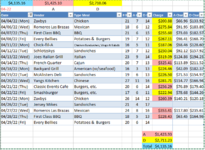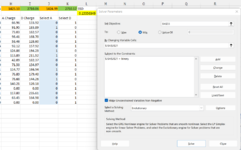melodramatic
Board Regular
- Joined
- Apr 28, 2003
- Messages
- 187
- Office Version
- 365
- Platform
- Windows
This is probably the strangest query I've put before you, and I think it's probably a dud. But, I'm hoping that someone can prove me wrong.
I am in charge of our daily lunch here at work, and break that lunch down on my credit card according to how many people from our two buildings (A&D) were on the lunch list. Accordingly, I charge out per the average meal cost against the number per building.
All has worked well since I took on this task a year ago. UNTIL, I.T. let some wonder-consultant change out all of our accounting software. I am no longer able to go into each charge and split it to different accounts - every single charge can go to only one charge code now. So much for splitting.
Luckily, I do my charge-outs only once a month (and that day is coming up on Wednesday, when May ends). What I'm planning on doing is taking the total of the charges for the month (using the April figures here, that was $1,425.10 for Bldg A, and $2,710.06 for Bldg D), and pulling receipts that match closest to that amount. Yes, the shortcut system that we now have in accounting takes us all 4x the amount of time to do accounting work.
Sorry, I digress in my frustration.
So, is there a way that I can tell Excel - "hey - if you look at the "A Charge" column in the table, (starting at Row 3, you're in a table), find me the receipts that will bring me the closest to $1,425.10?
Thanks in advance for looking at this!
I am in charge of our daily lunch here at work, and break that lunch down on my credit card according to how many people from our two buildings (A&D) were on the lunch list. Accordingly, I charge out per the average meal cost against the number per building.
All has worked well since I took on this task a year ago. UNTIL, I.T. let some wonder-consultant change out all of our accounting software. I am no longer able to go into each charge and split it to different accounts - every single charge can go to only one charge code now. So much for splitting.
Luckily, I do my charge-outs only once a month (and that day is coming up on Wednesday, when May ends). What I'm planning on doing is taking the total of the charges for the month (using the April figures here, that was $1,425.10 for Bldg A, and $2,710.06 for Bldg D), and pulling receipts that match closest to that amount. Yes, the shortcut system that we now have in accounting takes us all 4x the amount of time to do accounting work.
Sorry, I digress in my frustration.
So, is there a way that I can tell Excel - "hey - if you look at the "A Charge" column in the table, (starting at Row 3, you're in a table), find me the receipts that will bring me the closest to $1,425.10?
Thanks in advance for looking at this!
| $4,135.16 | $1,425.10 | $2,710.06 | ||||||
| 04-22 | A | D | ||||||
| Date | Vendor | Type Meal | # Meals | A # | D # | Charge | A Charge | D Charge |
| 04/04/22 (Mon) | Zaxbys | Chicken | 21 | 7 | 14 | $200.88 | $66.96 | $133.92 |
| 04/06/22 (Wed) | Romeros Las Brazas | Mexican | 18 | 6 | 12 | $275.84 | $91.95 | $183.89 |
| 04/07/22 (Thu) | First Class BBQ | BBQ | 21 | 6 | 15 | $255.60 | $73.03 | $182.57 |
| 04/08/22 (Fri) | Every Bellies | Potatoes & Burgers | 19 | 7 | 12 | $267.11 | $98.41 | $168.70 |
| 04/11/22 (Mon) | Chick-fil-A | Chicken Sandwiches, Wraps & Salads | 16 | 5 | 11 | $187.06 | $58.46 | $128.60 |
| 04/12/22 (Tue) | Schlotzskys | Sandwiches | 19 | 7 | 12 | $250.04 | $92.12 | $157.92 |
| 04/13/22 (Wed) | Joes Italian Grill | Italian | 23 | 9 | 14 | $319.09 | $124.86 | $194.23 |
| 04/14/22 (Thu) | French Quarter | Cajun | 20 | 7 | 13 | $325.41 | $113.89 | $211.52 |
| 04/18/22 (Mon) | Backyard Grill | American (w/seafood) | 16 | 3 | 13 | $224.46 | $42.09 | $182.37 |
| 04/19/22 (Tue) | McAlisters Deli | Sandwiches | 19 | 6 | 13 | $226.50 | $71.53 | $154.97 |
| 04/20/22 (Wed) | Yangs Kitchen | Chinese | 27 | 11 | 16 | $281.71 | $114.77 | $166.94 |
| 04/21/22 (Thu) | Classic Events Cafe | Burgers, etc. | 20 | 6 | 14 | $256.29 | $76.89 | $179.40 |
| 04/22/22 (Fri) | Smashburger | Burgers, etc. | 17 | 6 | 11 | $222.94 | $78.68 | $144.26 |
| 04/25/22 (Mon) | Zaxbys | Chicken | 26 | 14 | 12 | $260.39 | $140.21 | $120.18 |
| 04/26/22 (Tue) | Jersey Mikes | Sandwiches | 21 | 4 | 17 | $0.00 | $0.00 | |
| 04/27/22 (Wed) | Romeros Las Brazas | Mexican | 24 | 8 | 16 | $353.41 | $117.80 | $235.61 |
| 04/28/22 (Thu) | First Class BBQ | BBQ | 18 | 5 | 13 | $228.43 | $63.45 | $164.98 |
| 04/29/22 (Fri) | Every Bellies | Potatoes & Burgers | 20 | 6 | 14 | $0.00 | $0.00 |









